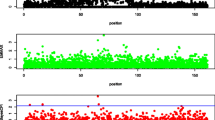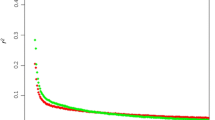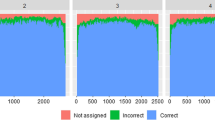Abstract
In recent years, several F2 crosses between outbred lines of livestock have been developed to identify quantitative trait loci (QTL). These populations are valuable for further genetic analysis, including positional candidate gene loci (CGL). Analysis of CGL in F2 populations is, however, hindered by extensive between-breed linkage disequilibrium (LD). The objectives here were to develop and evaluate three tests for CGL in simulated F2 breed-cross populations. 1) A standard association test, based on the fixed effect of CGL genotype. This test was significant for CGL at considerable distances from the QTL. 2) A marker-assisted association test, based on a test at the CGL of the fixed effect of CGL genotype in a breed-cross QTL interval mapping model. This removed the impact of between-breed LD, but was not powerful in detecting CGL closely linked to the QTL, unless the CGL was the QTL. 3) An F-drop test, comparing F ratios for a QTL at the CGL with and without the CGL included as fixed effect. It had low power to distinguish close from distant CGL. Power to distinguish two CGL within 10 cM from the QTL was limited and little improved by including QTL effects associated with markers to remove between-breed LD, although the power was greater when one of the CGL was the causative mutation. Therefore, while we conclude that candidate gene tests in QTL mapping populations must be interpreted with caution, we now have a clearer picture of the value of candidate gene tests in these populations.





Similar content being viewed by others
References
L Andersson CS Haley H Ellegren SA Knott M Johansson et al. (1994) ArticleTitleGenetic mapping of quantitative trait loci for growth and fatness in pigs. Science 263 1771–1774 Occurrence Handle1:CAS:528:DyaK2cXivFWiu78%3D Occurrence Handle8134840
D Ciobanu J Bastiaansen M Malek J Helm J Woollard et al. (2001) ArticleTitleEvidence for new alleles in the protein kinase adenosine monophosphate-activated γ3-subunit gene associated with low glycogen content in pig skeletal muscle and improved meat quality. Genetics 159 1151–1162 Occurrence Handle1:CAS:528:DC%2BD38XjvVamsQ%3D%3D Occurrence Handle11729159
DJ De Koning LLG Janss AP Rattink PAM van Oers BJ de Vries et al. (1999) ArticleTitleDetection of quantitative trait loci for backfat thickness and intramuscular fat content in pigs (Sus scrofa). Genetics 152 1679–1690 Occurrence Handle1:STN:280:DyaK1MzlvFCgtA%3D%3D Occurrence Handle10430592
F Farnir W Coppieters J-J Arranz P Berzi N Cambisano et al. (2000) ArticleTitleExtensive genome-wide linkage disequilibrium in cattle. Genome Res 10 220–227 Occurrence Handle10.1101/gr.10.2.220 Occurrence Handle1:CAS:528:DC%2BD3cXhsVOks70%3D
CS Haley SA Knott JM Elsen (1994) ArticleTitleMapping quantitative trait loci in crosses between outbred lines using least squares. Genetics 136 1195–1207 Occurrence Handle1:CAS:528:DyaK2MXpsFCr Occurrence Handle8005424
RC Lewontin (1964) ArticleTitleThe interaction of selection and linkage. I. General considerations; heterotic models. Genetics 49 49–67
H Li N Deeb H Zhou AD Mitchell CM Ashwell et al. (2003) ArticleTitleChicken quantitative trait loci for growth and body composition associated with transforming growth factor-β genes. Poult Sci 82 347–356 Occurrence Handle1:CAS:528:DC%2BD3sXivVGqur8%3D Occurrence Handle12705392
LL Lo RL Fernando M Grossman (1993) ArticleTitleCovariance between relatives in multibreed populations: additive model. Theor Appl Genet 87 423–430
M Malek JCM Dekkers HK Lee TJ Baas MF Rothschild (2001a) ArticleTitleA molecular genome scan analysis to identify chromosomal regions influencing economic traits in the pig. I. Growth and body composition. Mamm Genome 12 630–636 Occurrence Handle1:CAS:528:DC%2BD3MXltlyqtrc%3D
M Malek JCM Dekkers HK Lee TJ Baas K Prusa et al. (2001b) ArticleTitleA molecular genome scan analysis to identify chromosomal regions influencing economic traits in the pig. II. Meat and muscle composition. Mamm Genome 12 637–645 Occurrence Handle1:CAS:528:DC%2BD3MXltlyqt74%3D
AF McRae JC McEwan KG Dodds T Wilson AM Crawford et al. (2002) ArticleTitleLinkage disequilibrium in domestic sheep. Genetics 160 1113–1122
Nguyen NT, Kim KS, Thomsen H, Helm J, Rothschild MF (2003) Investigation of a candidate gene for growth and fatness QTL on the pig chromosome 7. Proceedings of plant and animal and genome XI conference, San Diego, CA, p 230
J Riquet W Coppieters N Cambisano JJ Arranz P Berzi et al. (1999) ArticleTitleFine-mapping of quantitative trait loci by identity by descent in outbred populations: application to milk production in dairy cattle. Proc Natl Acad Sci USA 96 9252–9257 Occurrence Handle10.1073/pnas.96.16.9252 Occurrence Handle1:CAS:528:DyaK1MXltVequ78%3D Occurrence Handle10430929
GA Rohrer JW Keele (1998a) ArticleTitleIdentification of quantitative trait loci affecting carcass composition in swine: I. Fat deposition traits. J Anim Sci 76 2247–2254 Occurrence Handle1:CAS:528:DyaK1cXmsV2jtro%3D
GA Rohrer JW Keele (1998b) ArticleTitleIdentification of quantitative trait loci affecting carcass composition in swine: II. Muscling and wholesale product yield traits. J Anim Sci 76 2255–2262 Occurrence Handle1:CAS:528:DyaK1cXmsV2jtrs%3D
MF Rothschild M Soller (1997) ArticleTitleCandidate gene analysis to detect genes controlling traits of economic importance in domestic livestock. Probe 8 13–20
MF Rothschild C Jacobson D Vaske CK Tuggle L Wang et al. (1996) ArticleTitleThe estrogen receptor locus is associated with a major gene influencing litter size in pigs. Proc Natl Acad Sci USA 93 201–205 Occurrence Handle10.1073/pnas.93.1.201 Occurrence Handle1:CAS:528:DyaK28Xjslyiuw%3D%3D Occurrence Handle8552604
TH Short MF Rothschild OI Southwood DG McLaren A de Vries et al. (1997) ArticleTitleEffect of the estrogen receptor locus on reproduction and production traits in four commercial pig lines. J Anim Sci 75 3138–3142 Occurrence Handle1:CAS:528:DyaK2sXotVWgt78%3D Occurrence Handle9419986
TP Yu CK Tuggle CB Schmitz MF Rothschild (1995) ArticleTitleAssociation of PIT1 polymorphisms with growth and carcass traits in pigs. J Anim Sci 73 1282–1288 Occurrence Handle1:CAS:528:DyaK2MXlsFSjtLg%3D Occurrence Handle7665359
TP Yu L Wang CK Tuggle MF Rothschild (1999) ArticleTitleMapping genes for fatness and growth on pig chromosome 13: a search in the region close to the pig PIT1 gene. J Anim Breed Genet 116 269–280 Occurrence Handle10.1046/j.1439-0388.1999.00198.x Occurrence Handle1:CAS:528:DyaK1MXmsFOjtbo%3D
H Zhou AJ Buitenhuis S Weigend SJ Lamont (2001) ArticleTitleCandidate gene promoter polymorphisms and antibody response kinetics in chickens: interferon-γ, interleukin-2, and immunoglobulin light chain. Poult Sci 80 1679–1689 Occurrence Handle1:CAS:528:DC%2BD38XktFOktw%3D%3D Occurrence Handle11771881
Acknowledgements
This work was supported by CSREES IFAFS # 00-52100-9610. The authors thank Dan Nettleton for statistical advice and Radu Totir, Hauke Thomsen, Massoud Malek, Petek Settar, David Casey, Jing Wang, Joseph McElroy, and Napapan Chaiwong for helpful discussion and suggestions.
Author information
Authors and Affiliations
Corresponding author
Appendix
Appendix
The between- and within-breed LD in the simulated F2 populations is derived. Following Lo et al. (1993), the expected between-breed LD between the QTL and a candidate gene locus (CGL) in the F2 is ¼(1 − 2r)(P SireQ − P DamQ )(P SireC − P DamC ), where r is the recombination rate between the QTL and the CGL, and P Sirek and P Damk are the frequencies of allele k in the F0 sires and dams, respectively. Because alleles Q and C were simulated with the same frequencies in the F−20, their frequencies in the F0 are expected to be the same, that is, P SireQ = P SireC = ½ (P AQ +P BQ ) and P DamQ = P DamC = ½ (P CQ +P DQ ), where P ik is the frequency of allele k in ancestral breed i in the F−20. Therefore, between-breed LD in the F2 was calculated as:

The LD that existed in the F−18 (Fig. 2) from the cross A × B in the F−20 is ¼(1 − 2r)(P AQ −P BQ )(P AC − P BC ) (Lo et al. 1993), which equals ¼(1 − 2r)(P AQ − P BQ )2 since frequencies of alleles Q and C were equal in the F−20. This LD decayed each generation by a factor (1 − r). Therefore, the LD that existed in the F0 sires is (1 − r)18[¼(1 − 2r)(P AQ -P BQ )2].
Similarly, the LD that existed in the F0 dams is (1 − r)18[¼(1 − 2r)(P CQ − P DQ )2], which equals (1 − r)18[¼(1 − 2r)(P AQ − P BQ )2] because P AQ − P BQ = P DQ − P CQ (Table 1). From the F0 to the F2, this LD was further reduced by (1−r)2, therefore, the expected within-breed LD between the QTL and a CGL in the F2 is:

Setting r = 0 in Eq [1], the expected between-breed LD within the QTL in the F2 is:

The within-breed LD for the QTL with itself in the F2 originated not only from the cross of ancestral breeds in the F−20, but also from the LD that existed in ancestral breed i, which is equal to P iQ (1 − P iQ ). Setting r = 0 in Eq [2] and adding the average LD within breeds A and B in the F−20, the expected within-breed LD for the QTL in the F2 is:

Rights and permissions
About this article
Cite this article
Zhao, H., Rothschild, M.F., Fernando, R.L. et al. Tests of candidate genes in breed cross populations for QTL mapping in livestock . Mamm Genome 14, 472–482 (2003). https://doi.org/10.1007/s00335-002-2215-y
Received:
Accepted:
Issue Date:
DOI: https://doi.org/10.1007/s00335-002-2215-y




